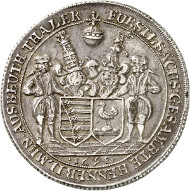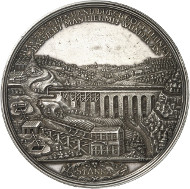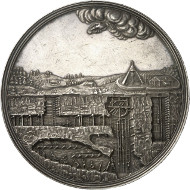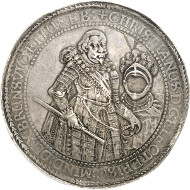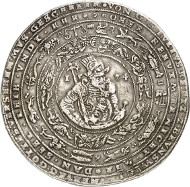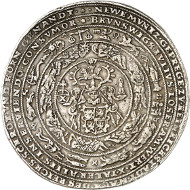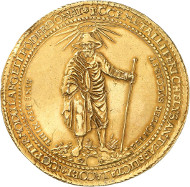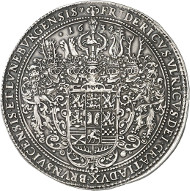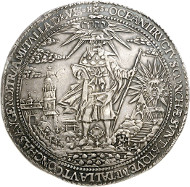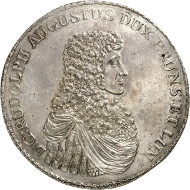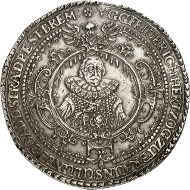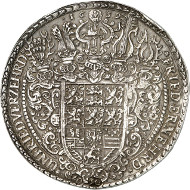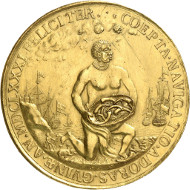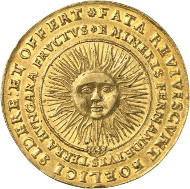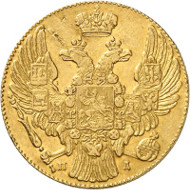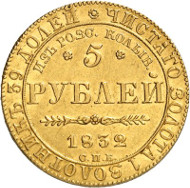29-10-2015 – 01-01-1970
Auction 1: Löser and mining coins from Preussag
Künker auctions off the largest collection of löser and mining coins ever offered for sale
Over the course of the previous decades, Preussag AG has assembled the largest collection of löser and mining coins in history. This collection will now be auctioned off by London Coin Galleries, in collaboration with Künker, in London. The range of pieces on offer comprises 217 löser and 327 mining coins.
Lot 349: HENNEBERG. Reichsthaler 1698, Ilmenau. Made of metal mined from the mines at Ilmenau. Nearly extremely fine. Estimate: 600,- GBP.
In 1923, the Prussian Landtag passed a bill, which, out of the state-run conglomerate of mines, foundries, saline and amber processing works, created a joint stock corporation called the Preußische Bergwerks- und Hütten-Aktiengesellschaft, or Preussag. At the time of its founding, this extensive company employed 31,000 workers. The company’s chief areas of activity were the processing of black and brown coal, metals, potash salt and halite. The exploration of petroleum and the manufacturing of petroleum products were still a marginal line of business back then.
Lot 381: SAXONY. John George III, 1680-1691. Silver medallion of 8 reichsthaler 1690, by M. H. Omeis. Very rare. Extremely fine. Estimate: 7,500,- GBP.
After financial difficulties in the late 1920s – Preussag was affected by the Great Depression as well – the company, because of the strategic importance of its production, bounced back. After the Nazis came to power, Preussag, being a state-owned company, was forced in line with the regime. The allied victory over Nazi Germany placed Preussag under compulsory administration. As late as 1947, it became a German institution again but was managed from Hannover instead of Berlin because of the different occupation zones.
Lot 471: TRIER. Reichsthaler 1616, Koblenz. Made of metal mined from the mines at Vilmar. Extremely rare. Nearly extremely fine. Estimate: 12,500,- GBP.
Next to the change of location for the Preussag headquarters, the corporation lost more than 70% of its original size due to the geographical placement of the majority of its subsidiaries in what was then behind the Iron Curtain. As demand for coal declined in the 1950s, the company underwent a major restructuring. Again a joint stock company since 1959, Preussag attempted to break into the market of body care products and become established in other lines of business as well. It was only in 1973, that Preussag got back to its core business, which, in combination with the 1974 oil crisis, earned the company enormous profits.
The biggest turning point in corporate history came, when in conjunction with another diversification, Preussag acquired Hapag-Lloyd in 1997. In doing so, Preussag entered the transportation business and the tourism industry soon after. TUI, as Preussag renamed itself in 2002, is the world’s largest tourism group, currently covering nearly 70% of the European travel market.
Lot 115: BRUNSWICK-LÜNEBURG-CELLE. Christian, Bishop of Minden, 1611-1633. Löser of 10 reichsthaler 1625, Clausthal(?). Extremely rare. Extremely fine. Estimate: 50,000,- GBP.
The Preussag Collection, comprising löser, yield coins and mining coins, dates back to the company’s heyday during the 1970s. With the professional advice of Karl Müseler, Preussag assembled a unique collection during these years. Thanks to the 217 löser alone, the collection breaks all records. Neither the Meirhof Collection, comprising 170 löser, which were auctioned off on March 12, 1930, nor the Edward D. Milas Collection, whose 117 specimens were sold by Spink Taisei on October 21, 1992, can compete with that.
Lot 2: BRUNSWICK-WOLFENBÜTTEL. Julius, 1568-1589. Löser of 5 reichsthaler 1574, Heinrichstadt (Wolfenbüttel), struck in the weight of 4 1/2 reichsthaler. Extremely rare. Very fine. Estimate: 20,000,- GBP.
Where to start with this auction preview? What to skip? After all, virtually everything would be worth mentioning. What this Künker sale has to offer is more than spectacular. The first part of the auction offers virtually every löser type, represented by several specimens in various weights. Let us single out one telling example: the juliuslöser, the first löser, issued in the years after 1574. The auction presents the following dates of this coin: 1574 (of 10 and 5 reichsthaler), 1576 (of 5 and 2 1/2 reichsthaler), 1578 (of 10 and 3 reichsthaler), 1583 (of 10 reichsthaler), 1585 (of 3 reichsthaler), and 1588 (of 8 and 3 reichsthaler). That makes twelve opportunities to acquire an example of this juliuslöser, their estimates ranging between 1,500 GBP and 20,000 GBP. And there is much more.
Lot 43: BRUNSWICK-WOLFENBÜTTEL. Frederick Ulrich, 1613-1634. Gold löser of 17 ducats 1625, Goslar or Zellerfeld. Made of metal mined from the St. Jakob Mine at Lautenthal. Specimen from the Pogge and Vogelsang Collection. Unique. Extremely fine. Estimate: 150,000,- GBP.
Of course, the extraordinary rarities deserve special mentioning here. An item which stands out is a gold jakobslöser of 17 ducats from 1625, minted by Frederick Ulrich of Brunswick-Wolfenbüttel. The specimen depicts Jacobus the Elder and thus refers to the St. Jakob Mine at Lauenthal. On behalf of the duke, the mint was put under control of the Brunswick mining administration in 1623, and was made lucrative through a major capital investment. The pre-sale estimate of this unique item amounts to 150,000 GBP. Admittedly, that is an impressive sum, yet it still ranges at the lower end of what this exceptional piece may be worth.
Lot 47: BRUNSWICK-WOLFENBÜTTEL. Frederick Ulrich, 1613-1634. Löser of 10 reichsthaler 1634, Zellerfeld. Made of metal mined from the St. Jakob Mine at Lautenthal. Very rare. Extremely fine. Estimate: 40,000,- GBP.
There is hardly any need to stress that all other jakobslöser come in every possible weights and variants as well. Yet the following needs to be mentioned: the 1634 jakobslöser of 10 reichsthaler, estimated at 40,000 GBP, which depicts not only the apostle on the obverse but also the St. Jakob Mine in the field on the right and what most likely is the Baroque church of Santiago di Compostela on the left. This coin is a class of its own with its extremely fine grade.
Lot 105: BRUNSWICK-WOLFENBÜTTEL. Rudolph Augustus, 1666-1685. Löser of 4 reichsthaler 1679, Zellerfeld. Unique? Extremely fine to FDC. Estimate: 40,000,- GBP.
Likewise marvelous is a 1679 löser of 4 reichsthaler from Zellerfeld, which Rudolph Augustus had minted to mark the capture of independent Brunswick. The finest specimen known to exist was struck in the weight of 4 reichsthaler and is now estimated at 40,000 GBP.
The estimate of a löser of Christian, Bishop of Minden, is 50,000 GBP. On the obverse of this unique example, Christian is shown in full Baroque armor.
Lot 130: BRUNSWICK-LÜNEBURG-CELLE. Frederick, 1636-1648. Löser of 10 reichsthaler 1639, Clausthal. Unique. Extremely fine. Estimate: 60,000,- GBP.
60,000 GBP is the pre-sale estimate of the unique löser of Frederick of Brunswick-Lüneburg-Celle, which depicts his facing bust within a Baroque decorative frame, wearing a large ruff collar. By the way, you do not have to be a millionaire to afford a löser. Very fine specimens are available for estimates as low as 500 GBP.
The same applies to mining coins. The lowest estimates amount to 500 GBP. However, it is quite easy to spend much more money on one of those spectacular yield coins and coins and medals depicting views of mines. The specimens’ geographical spectrum ranges from Germany, which contributes the lion share of the material, to rarities from the Habsburg Empire and the rest of Europe, respectively, supplemented by some extraordinary items from overseas. They range in date from the 16th to the 20th century.
We would like to introduce three outstanding pieces at this point:
Lot 227: BRANDENBURG. Frederick William, 1640-1688. Gold medal of 25 ducats 1681, Emden. Made of gold brought home by the first expedition of the African Trading Company. From the possession of Frederick II, King of Prussia. Unique. Extremely fine. Estimate: 75,000,- GBP.
With lot 227 a gold medal of 25 ducats from 1681 is offered for sale. Frederick William of Brandenburg-Prussia ordered its production, using gold brought back from Captain Philipp Pietersen Blonck’s first expedition to the coast of Guinea and Angola. This unique specimen, graded extremely fine, has been estimated at 75,000 GBP, which is not much considering its pedigree: it belonged to the Prussian King Frederick II before he sold it in the 18th century.
Lot 485: HRE. Ferdinand III, 1625-1637-1657. 10 ducats 1648. Made of metal mined from the Ferdinand Mine at Schemnitz. Probably unique. Extremely fine. Estimate: 100,000,- GBP.
100,000 GBP is the estimate of a 1648 yield coin of Ferdinand III. The unique specimen has been made of gold mined from the Ferdinand Mine at Schemnitz in Hungary. Its reverse depicts the sun as the planet that symbolizes gold. The legend on the reverse translates as follows: Under lucky stars fate is recreated, and Hungary offers to you, Ferdinand, the fruit of your mines.
Lot 532: RUSSIA. Nicholas I, 1825-1855. 5 rouble 1832, St. Petersburg. Made of metal mined from the gold mines at Kolyvan. Very rare. Good very fine. Estimate: 20,000,- GBP.
Lot 532 comprises a Russian yield rouble of Nicholas I from 1832, made of gold mined from the famous Kolyvan mines. Its yields were something even the Prussian King Frederick wanted to be informed about by his ambassador John Eustace of Goertz. The very rare specimen is estimated at 20,000 GBP.
The lavishly illustrated catalog, written in German, may be ordered at Künker, Nobbenburgerstrasse 4a, D-49 076 Osnabrück; phone +49 (0)541 / 96 20 20; telefax: +49 (0)541 / 96 20 222; or by writing an email.
All coins on offer can be viewed online here.



